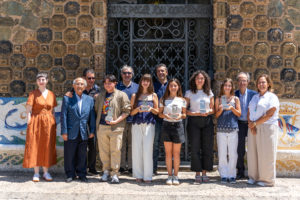December 14, 2023
By: Bellesguard Team

The biblical account of the birth of Christ does not provide a specific date for when it took place. In fact, during the following two centuries, no one bothered to find out. The origin of Christmas dates back to the year 313, when Christianity became the official religion of the Roman Empire. It was only then, after many discussions, that it was decided that the birth of Christ would be on December 25th, following the tradition of Solis Invicti, a Roman cult dedicated to the sun.
However, the different elements of Christmas would gradually emerge in the following centuries. For example, the first Nativity scene was set up by Saint Francis of Assisi in 1223, and the first Christmas tree was decorated in 1441 in Tallinn (Estonia) or in 1510 in Riga (Latvia).
For the first parade of the Three Wise Men in Barcelona, we had to wait until 1855. The tradition of eating 12 grapes must be placed around 1909, the year in which Gaudí completed the Bellesguard Tower… as we can see, Christmas, more than a tradition, is the sum of different traditions, sometimes with quite surprising origins (1).
Although Christmas is now a fairly international holiday, Catalonia has its own peculiarities. This includes, among other things, the celebration of Saint Stephen’s Day (2), which dates back to the Carolingian era, and two other, more “modern,” traditions that seem to originate in the 18th century: the Christmas log (“tió”) (3) and the “caganer” (4).
Saint Stephen’s Day
The origin of the celebration of Saint Stephen’s Day dates back to the Middle Ages. The tradition that persists to this day brings the entire family together around the same table on Christmas Day. This involved long walks on foot to the family home. In the Middle Ages, when transportation was precarious and distances were long, people needed time to return home on the day after Christmas, which is why the 26th ended up becoming a holiday.
According to some historians, the need for a day of travel to return home led the Carolingian Empire to declare the day after each major holiday (Christmas, Easter, and Epiphany) a holiday. Today, in Catalonia, it is traditional for the family to gather for a meal with the other half that could not be there on Christmas. For Christmas, it is customary to have broth and cannelloni, while for Saint Stephen’s Day, it is stuffed chicken.
The Christmas Log (“Tió”)
According to some historians, the tradition of the “tió” dates back to pre-Christian traditions, where thanks were given for the abundance of harvests to survive the winter, thanks to wood for burning and heating the home, and gathering the whole family around the fire and light during the dark and cold winter months. According to these ancient cults, food was offered to this log before the arrival of winter.

Currently, the “tió” is either sought in the forest or appears at home around the Feast of the Immaculate Conception. It is placed next to the Christmas tree, covered with a blanket, and fed until Christmas Eve. On Christmas Eve or on December 25th, the youngest ones “make the tió poop” by hitting it with a wooden stick while singing carols. The “tió” “poops” nougats, toys, and sweets.
In the past, after making it “poop,” the “tió” was burned in the fireplace, and its ashes were scattered in the fields in a ritual to promote fertility and abundance for the following year.
The “Caganer”
Finally, the “caganer” is believed to be related to a ritual for the abundance and fertility of the land, as it is a character who “fertilizes” the earth with his excrement. It is believed that the tradition comes from the Baroque period, a cultural and artistic movement characterized by its realism. We can imagine that it is very likely that the peasants who went to welcome the infant Jesus had to relieve themselves somewhere, hidden in a corner to avoid strange looks.

Currently, the “caganer” has evolved and is no longer just the traditional shepherd, with a cloak, espadrilles, and beret, smoking a pipe, but you can find the parody of any famous figure, from politics, culture, or sports, doing their business in a corner of the nativity scene. An endearing character that appeals to both young and old.
In summary, we can affirm that Christmas is the sum of many traditions and cults, not all of them religious, and is very difficult to date precisely, but they all have something in common: they are part of one of the most anticipated festivities of the year, especially for the youngest ones.
At Bellesguard, Antoni Gaudí pays homage to Christmas, placing on the main facade one of the first symbols of Christianity: the Star that guided the Three Wise Men to the place where Jesus was born: the Star of the East. A star that, in its early images, is represented as an eight-pointed star, just like the star in the vestibule of Bellesguard. (link)
A star full of colors and light. With its brilliance, we invite you to enjoy Bellesguard this Christmas, hoping that your 2024 is equally bright.
Notes
(1) Pepe Rodríguez (2010), Myths and Traditions of Christmas, Ediciones B, Barcelona
(2) “Why is Saint Stephen’s Day only celebrated in Catalonia?” (12/13/2022), Barcelona.cat website. Link
(3) García, Cristina (12/16/2021), “The curious origin of the Tió and the Caga Tió to explain to children,” DiraiMes. Link
(4) Jones, Jessica (12/23/2022), “Caganers: the scatological and beloved custom of Christmas in Catalonia,” BBC Travel. Link




